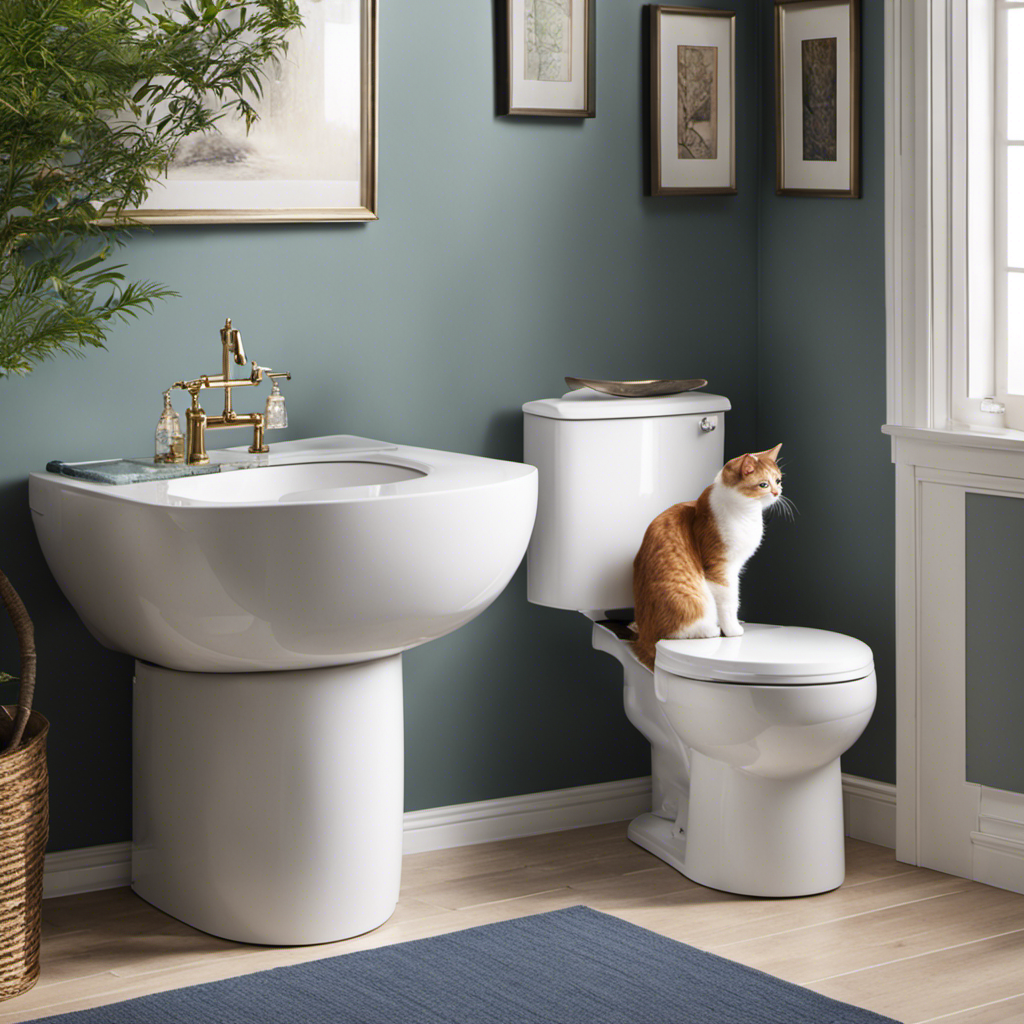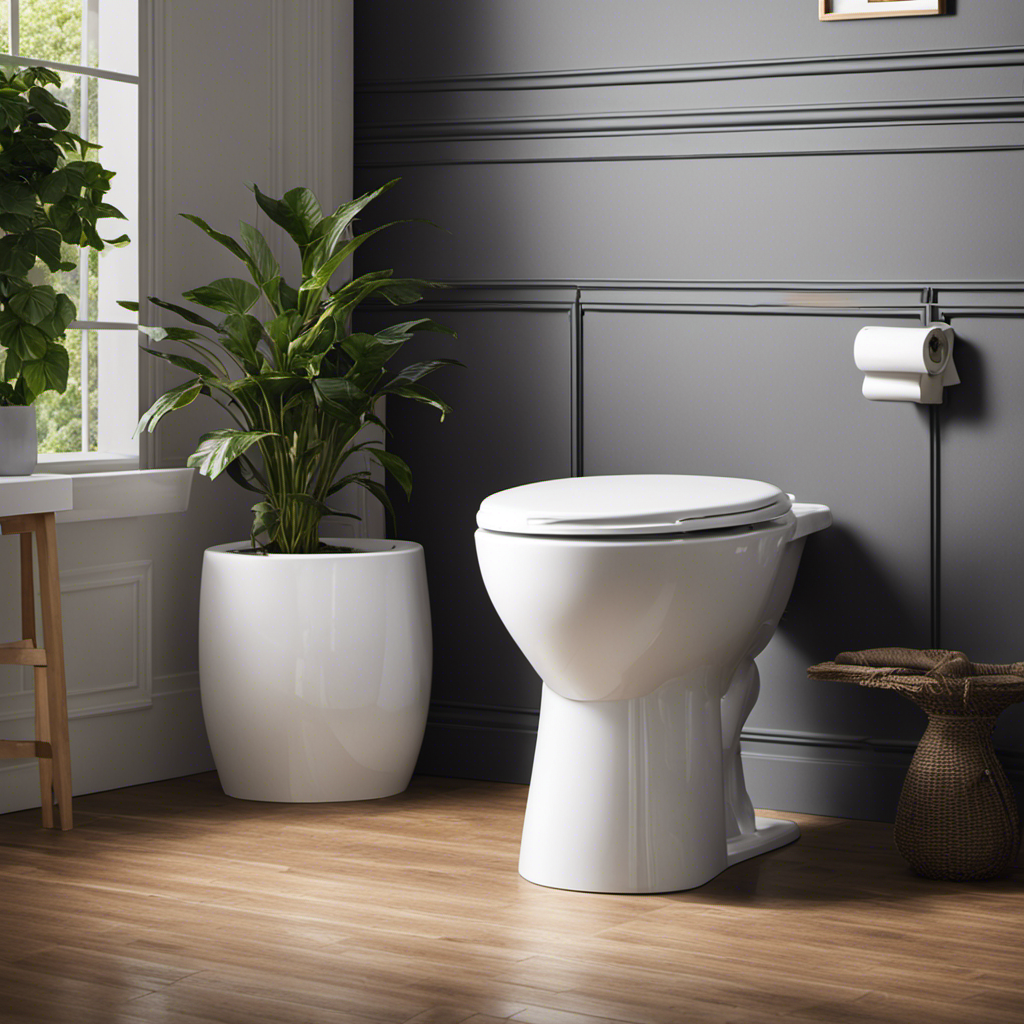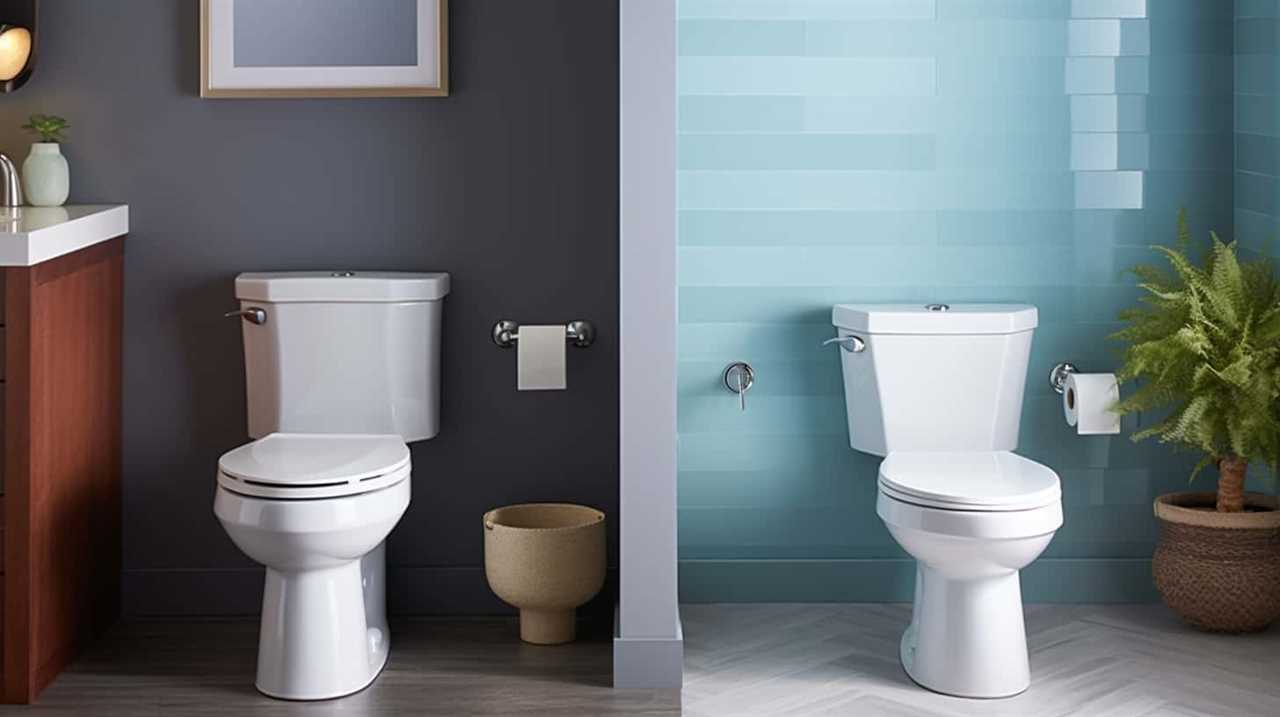I’ve always dreamt of a world where I never have to scoop litter again. Well, my dreams came true when I successfully toilet trained my cat! If you’re tired of dealing with litter boxes and ready to embark on this exciting journey, you’ve come to the right place.
In this article, I’ll guide you through the step-by-step process of toilet training your feline friend. Get ready to say goodbye to litter and hello to a cleaner, more convenient way for your cat to do their business.
Key Takeaways
- Choose the right litter box and location for your cat’s comfort and privacy.
- Gradually transition your cat to the toilet using special litter boxes or training seats.
- Use positive reinforcement techniques and rewards to encourage desired behaviors.
- Be consistent in training, establish a schedule, and avoid punishments.
Select the Right Litter Box
Make sure you’re using the right litter box for your cat. Choosing the correct litter box size is crucial for your cat’s comfort. It should be large enough for your cat to turn around and dig comfortably. A litter box that is too small can make your cat feel cramped and discouraged from using it.
Additionally, consider the placement of the litter box. Cats prefer privacy when using the litter box, so it should be placed in a quiet and secluded area of your home. Avoid placing it near their food or water bowls as cats like to keep their eating and elimination areas separate.
Now that you have the right litter box, let’s talk about how to gradually transition to the toilet.
Gradually Transition to the Toilet
Start by slowly introducing your feline friend to the idea of using the bathroom on their own. Transitioning from a litter box to the toilet can be a challenging process for some cats, but with patience and the right training methods, it can be accomplished.
It’s important to understand that every cat is different, and some may have more difficulties with the transition than others. If your cat is struggling, there are alternative training methods you can try.
One method is to use a special litter box that gradually raises the height of the litter until it resembles a toilet seat. This helps your cat become accustomed to the elevated surface and prepares them for the next step of using the actual toilet.
Another alternative method is to use a training seat that fits directly onto the toilet, gradually replacing the litter box with the seat.
Use Training Techniques and Rewards
When it comes to training your cat, there are a few key points to keep in mind.
First, positive reinforcement techniques are essential for successful training. By rewarding your cat’s desired behaviors with treats or praise, you can encourage them to continue behaving in a way that you want.
Second, consistency in training is crucial. Make sure to establish clear rules and expectations for your cat and stick to them consistently.
Positive Reinforcement Techniques
Toilet training your cat involves using positive reinforcement techniques. This includes rewarding them with treats and praise when they successfully use the litter box. By doing this, you help them associate the behavior with positive outcomes and encourage them to continue using the litter box.
Here are some effective techniques for positive reinforcement:
-
Treats: Give your cat a special treat every time they use the litter box correctly. This creates a positive association with the behavior.
-
Praise: Lavish your cat with praise and affection when they use the litter box. They will appreciate the positive attention and be more motivated to repeat the behavior.
-
Clicker training: Use a clicker to signal to your cat that they have done something right. Pair the click with a treat or praise to reinforce the desired behavior.
-
Litter box alternatives: Explore different litter box options, such as self-cleaning or top-entry litter boxes, to find one that your cat prefers and feels comfortable using.
Consistency in Training
Using consistent reinforcement and positive rewards throughout the training process will help your furry friend learn the desired behaviors more effectively.
When it comes to training your cat, consistency is key. Establishing a training schedule will provide structure and help your cat understand what is expected of them. Set aside specific times each day to work on training and stick to that schedule as much as possible.
Additionally, be sure to consistently reward your cat for exhibiting the desired behaviors. This could be through praise, treats, or playtime. Avoid using punishments, as they can be counterproductive and may cause fear or anxiety in your cat.
Patience and Persistence
Remember, it can take time and effort, but staying patient and persistent with your furry friend will pay off in their training progress. Here are some key techniques to help you on your journey:
-
Consistency: Stick to a routine and provide your cat with ample opportunities to use their litter box.
-
Positive reinforcement: Reward your cat with treats and praise when they use the litter box correctly.
-
Problem-solving: If accidents happen, clean them up without scolding your cat. Instead, focus on redirecting their behavior to the litter box.
-
Environmental enrichment: Make sure your cat has access to multiple clean litter boxes in different locations to increase their chances of success.
Perseverance and determination are essential when toilet training a cat. Remember, accidents may occur, but with consistent training methods and techniques, your cat will eventually learn to use the litter box consistently. Stay patient, stay persistent, and you will see progress.
Manage Accidents and Setbacks
When it comes to managing accidents and setbacks during the toilet training process, there are a few key points to keep in mind.
First, it’s important to promptly clean up any accidents to prevent the cat from associating that area with a designated bathroom spot.
Additionally, reinforcing positive behavior when the cat successfully uses the litter box can help encourage them to continue doing so.
Lastly, patience and consistency are crucial in this process, as it may take some time for the cat to fully grasp the concept of using the litter box.
Cleaning up Accidents
If your cat has an accident, it’s important to quickly clean up the mess to prevent any lingering odors. Here are some cleaning techniques to help you tackle the task effectively:
-
Act promptly: The sooner you clean up the mess, the easier it will be to remove any stains or odors.
-
Blot, don’t rub: Use a paper towel or cloth to gently blot the affected area, absorbing as much liquid as possible.
-
Use an enzyme-based cleaner: These cleaners are specially designed to break down the proteins in cat urine, eliminating both stains and odors.
-
Avoid ammonia-based products: Cats are naturally attracted to the scent of ammonia, so using ammonia-based cleaners may actually encourage them to return to the same spot.
Reinforcing Positive Behavior
Now that we’ve discussed how to clean up accidents, let’s move on to reinforcing positive behavior when toilet training a cat.
Training methods and behavior modification play a crucial role in effectively teaching your cat to use the toilet. One effective method is using positive reinforcement, which involves rewarding your cat for exhibiting the desired behavior.
When your cat successfully uses the toilet, praise them and offer a small treat as a reward. This helps them associate using the toilet with positive experiences.
Additionally, consistency is key. Stick to a regular toilet training schedule and ensure that everyone in the household follows the same rules and routines.
Patience and Consistency
Remember, it’s important to be patient and consistent in your approach to reinforce positive behavior during the toilet training process. Building trust and establishing routines are key elements in successfully toilet training your cat.
Here are four important tips to help you stay patient and consistent:
-
Set a consistent schedule: Cats thrive on routine, so establish a regular feeding and litter box cleaning schedule to help them understand when and where to eliminate.
-
Use positive reinforcement: Reward your cat with treats, praise, and affection every time they use the toilet or show progress. This encourages them to associate the desired behavior with positive experiences.
-
Be patient: Rome wasn’t built in a day, and neither will your cat’s toilet training progress. Stay calm and patient throughout the process, understanding that accidents may happen.
-
Stay consistent: Stick to the plan and avoid any sudden changes or disruptions that may confuse your cat. Consistency is key to building trust and reinforcing positive behavior.
With these tips in mind, you’ll be well on your way to successfully toilet training your cat.
Now, let’s move on to the next step: teaching your cat to flush.
Teach Your Cat to Flush
To teach your cat to flush, start by rewarding them with treats every time they successfully use the toilet. This positive reinforcement will create an association between using the toilet and receiving a reward, encouraging them to repeat the behavior.
However, teaching a cat to actually flush the toilet can be a bit trickier. Some cats may naturally be curious about the flushing sound and learn to do it on their own, but others may need some guidance.
One alternative method is to use a flushable litter and gradually transition your cat from a litter box to the toilet. By gradually reducing the amount of litter in the box and placing it on top of the toilet, your cat will learn to associate the act of eliminating with the toilet itself.
With patience and consistency, your cat may eventually learn to flush on their own, making the toilet training process even more convenient.
Maintain Hygiene and Cleanliness
Maintaining hygiene and cleanliness is essential for the health and well-being of your furry friend. As a responsible cat owner, it’s important to take the necessary steps to keep your cat’s environment clean and odor-free. Here are four practical tips to help you achieve this:
-
Regularly clean the litter box: Scoop the litter daily and change it completely every week to prevent odor buildup.
-
Use an odor control litter: Choose a litter that is specifically designed to control and eliminate odors, keeping your home smelling fresh.
-
Place a litter mat outside the box: This will help prevent litter tracking, as the mat catches any loose particles before they can be spread around the house.
-
Clean the surrounding area: Regularly vacuum or sweep the area around the litter box to remove any stray litter and prevent it from being tracked throughout your home.
Troubleshooting Common Challenges
If your furry friend is having trouble using the litter box consistently, it may be helpful to observe their behavior and consult with a veterinarian for guidance. Troubleshooting training difficulties and dealing with resistance are common challenges when toilet training a cat. To address these issues, it’s important to identify the underlying reasons for their behavior and make necessary adjustments. For instance, if your cat is avoiding the litter box, it could be due to a dislike of the litter type or the location of the box. By experimenting with different litter options and finding a quiet and accessible spot for the box, you can encourage your cat to use it more consistently. Additionally, providing positive reinforcement, such as treats or praise, can reinforce desired behaviors and help overcome resistance.
| Troubleshooting Tips | Dealing with Resistance |
|---|---|
| Observe behavior and consult vet | Identify underlying reasons |
| Experiment with litter type and location | Provide positive reinforcement |
| Make necessary adjustments | Encourage desired behaviors |
Conclusion
In conclusion, toilet training a cat may seem daunting at first, but it can be achieved successfully with the right tools and techniques.
First, it’s important to select the right litter box. Choose one that is large enough for your cat to comfortably use and place it in a quiet and accessible location.
Next, gradually transition your cat to the toilet. Start by placing the litter box next to the toilet and gradually elevate it over time. Eventually, your cat will become comfortable using the toilet instead of the litter box.
Training techniques and rewards are also helpful in the process. Use positive reinforcement, such as treats or praise, when your cat successfully uses the toilet. This will motivate them to continue using it.
Accidents and setbacks are bound to happen, so it’s important to manage them properly. Clean up any accidents promptly and avoid scolding or punishing your cat. Instead, redirect them to the toilet and continue with the training process.
Teaching your cat to flush can be a fun and useful skill. Start by rewarding your cat when they touch the flush handle. Gradually increase their involvement until they can flush the toilet on their own.
Lastly, maintaining hygiene and cleanliness is crucial. Regularly clean the litter box or toilet to ensure a pleasant experience for your cat. This will also prevent any odors or messes in your home.
Remember, patience and consistency are key throughout the training process. With a little bit of luck and a lot of love, you and your cat will conquer this challenge together.










